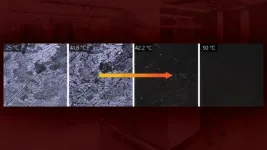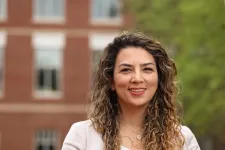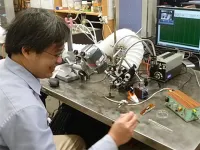(Press-News.org) SAN FRANCISCO – Wildfire management systems outfitted with remote sensing technology could improve first responders’ ability to predict and respond to the spread of deadly forest fires.
To do this, researchers at The Ohio State University are testing the use of Synthetic Aperture Radar, or SAR, to help with wildfire detection.
For many ecosystems, fires are vital tools that help to clear away plant waste, provide safer habitats for smaller species and burn off disease. Yet as Earth continues to experience warmer, drier conditions, the likelihood and severity of large, uncontrolled fire incidents that result in widespread environmental damage has steadily increased.
Between 2020 and 2023, wildfires across the U.S. burned over 25 million acres of land. At the same time, millions of people who reside near these at-risk areas are likely impacted by plumes of wildfire smoke, heightened flooding risks and property damage.
These effects underscore the need for better detection systems, said Dustin Horton, lead author of a new study on the subject and a doctoral student in electrical and computer engineering at Ohio State. His work revolves around improving traditional strategies for sensing large blazes and improving wildfire-related land management policies.
“There's a variety of prediction models that the government and different agencies use to predict and assess what an area might look like each wildfire season,” said Horton. “But a lot of those programs in recent history rely on a variety of remote sensing methods, such as optical sensors that have a lot of inherent disadvantages.”
For example, systems that use optical sensors to study targets, like LiDAR, can be occluded by wildfire smoke or other atmospheric changes like clouds or light from the sun. Other passive sensors can be less useful at night. Ultimately, these limitations diminish their effectiveness at collecting accurate measurements during a quickly evolving situation, and such setbacks could have disastrous effects on agencies aiming to gauge the number of resources or emergency service personnel needed to safely handle a large fire, said Horton.
The research was presented in a poster session today (Dec. 15, 2023) at the annual meeting of the American Geophysical Union. The poster suggests that one technique that could be used to supplement wildfire prediction models like the National Fire Danger Rating System, which allows users to estimate the next few days of fire danger in a given region, is to combine them with SAR.
Unlike optical or satellite infrared sensors, SAR utilizes radar to create high-resolution two-dimensional or three-dimensional reconstructions of terrain, making it an especially effective device for environmental mapping research. Additionally, since SAR remote sensing technologies can operate successfully during the day, night and inclement atmospheric events, it provides scientists the ability to finely measure an area’s surface geophysical, hydrological and meteorological properties at key spatial distances with ease, said Horton.
During the presentation, researchers noted that using SAR as an alternative wildfire sensing method also holds much potential for tracking the entire life-cycle and aftermath of a wildfire, as well as discerning and monitoring other factors that may contribute to creating flame-prone areas, such as the level of soil moisture in the region or various kinds of nearby vegetation.
The study concluded by noting how useful aerial SAR-based platforms could be to studying wildfires and other Earth processes across greater scales in the future. One such endeavor, planned to launch in early 2024, is the NISAR mission, a joint collaboration between NASA and the Indian Space Research Organisation (ISRO). The mission’s objective will be to map the entire Earth in an effort to provide the public with refined data about the effects of climate change on the planet’s crust.
Horton said that his team hopes to use the data the mission collects to continue building on their own wildfire-prediction algorithms, but will continue testing SAR as a next-generation wildfire assessment tool. In the meantime, Horton said that much of the responsibility for better understanding and stopping wildfires lies in combining both new technologies and tried-and-true fire services.
“Scientists can now identify areas with conditions where everything is perfect for a burn, all the models say it will and sometimes it just doesn’t,” said Horton. “Because the whole wildfire process is extremely complex, a lot of the heavy lifting still relies on the mitigation work of firefighters.”
Co-authors of the poster include Joel Johnson and Mohammad Al-Khaldi of Ohio State, Ismail Baris of the German Aerospace Center (DLR), Jeonghwan Park of NASA Goddard Space Flight Center and the Global Science and Technology Inc., and Rajat Bindlish of Goddard Earth Sciences Technology and Research.
#
Contact: Dustin Horton, Horton.378@osu.edu
Written by: Tatyana Woodall, Woodall.52@osu.ed
END
A new tool to better model future wildfire impacts in the United States
Study finds radar tech could improve current wildfire prediction systems
2023-12-15
ELSE PRESS RELEASES FROM THIS DATE:
Navigating climate challenges: UVA engineers and environmental scientists aid Virginia’s eastern shore
2023-12-15
Because of warming waters and melting glaciers, the sea level at Virginia’s Eastern Shore has risen almost 3 inches since 2016, and the projected trajectory looks ominous. The region, sandwiched between the Chesapeake Bay and the Atlantic Ocean, has one of the highest rates of relative sea-level rise on the Atlantic coast. The Virginia Institute of Marine Science’s Center for Coastal Resource Management projects a relative sea-level rise between 4.5 to 7 feet by 2100, which is three to four times the global average.
Hampton, Virginia — its neighbor across the bay — ranks second only to New Orleans as the largest population center ...
Using AI to pinpoint hidden sources of clean energy underground
2023-12-15
SAN FRANCISCO – As efforts to transition away from fossil fuels strengthen the hunt for new sources of low-carbon energy, scientists have developed a deep learning model to scan the Earth for surface expressions of subsurface reservoirs of naturally occurring free hydrogen.
Researchers used the algorithm to help narrow down the potential whereabouts of ovoids or semicircular depressions (SCDs) in the ground that form near areas associated with natural or “gold hydrogen” deposits. Though these circular ...
A study from IMDEA Software researchers reveals hidden fortunes and surprising overestimations in cybercrime revenue
2023-12-15
To what extent methodological limitations and incomplete data impact the revenue estimations of cybercriminal groups using the Bitcoin blockchain was largely unknown. A new study, conducted by IMDEA Software Institute researchers Gibran Gomez, Kevin van Liebergen, and Juan Caballero challenges existing figures regarding cybercriminals' Bitcoin earnings to date. The study, entitled "Cybercrime Bitcoin Revenue Estimations: Quantifying the Impact of Methodology and Coverage", recently presented at the ...
Department of Defense grant boosts study of pressure, humidity on thermal energy storage
2023-12-15
Under the Defense University Research Instrumentation Program, Dr. Patrick Shamberger and a research team from the Department of Materials Science and Engineering received a grant from the U.S. Department of Defense (DOD) to acquire instrumentation for thermal energy storage research.
The grant, administered through the Office of Naval Research, will support the acquisition of a high-sensitivity multi-modal calorimeter for advanced research and education on tunable energy storage materials. This equipment will allow cutting-edge research to study the capability of pressure and humidity to control how well these materials can store ...
IU researchers fill the final gaps in the Arabidopsis genome sequence and gain insights into gene regulatory mechanisms relevant to humans
2023-12-15
Arabidopsis thaliana is a species grown worldwide for genetic research and was the first plant to have its complete set of chromosomes (its genome) sequenced. The initial genome sequence, released in the year 2000, had numerous gaps, but technological improvements in the years since closed the gaps, one by one, until only two remained: large undefined regions on chromosomes 2 and 4 where genes encoding ribosomal RNAs are repeated in hundreds of copies. These ribosomal RNA gene clusters, known as nucleolus organizer regions (NORs), are not just difficult to define in Arabidopsis; gaps remain at ...
Toward more precise and flexible targeted spectroscopy measurements in the retina
2023-12-15
Many ocular diseases involve changes in the structure and function of different regions of the back of the eye, also known as the “eye fundus.” For example, fluorescent pigments and tiny yellowish deposits called drusen accumulate under the retina in age-related macular degeneration, and the degeneration of neurons called ganglion cells is a defining characteristic of glaucoma. Interestingly, changes in the eye fundus are not restricted to vision-related diseases only. Certain neurological diseases like Parkinson’s and Alzheimer’s can cause changes in retinal nerves and ...
UVA biomedical engineer unveils the dynamics of maternal immune responses
2023-12-15
Sepideh Dolatshahi, an assistant professor of biomedical engineering at the University of Virginia, is spearheading an exploration of systems immunology in its crucial development phase — during pregnancy.
Systems immunology is about unraveling concealed patterns within the human immune system, said Dolatshahi, whose approaches to her research span computational modeling, systems serology and cutting-edge spatial analysis techniques to investigate immune interactions between mother and fetus during pregnancy that could later support early childhood immunity.
Designing Tailored and Effective Vaccine Plans
Babies are immunocompromised ...
Novel therapeutic target overcomes resistance to radiation therapy
2023-12-15
A new study finds that radiation therapy (RT) suppresses a key protein called bone morphogenetic protein and activin membrane-bound inhibitor (BAMBI) and activates immune suppressive cells. These effects dampen the capacity of cancer-fighting immune cells and decrease the effectiveness of radiation, inducing therapy resistance in cancer patients, according to a paper published December 15, 2023 in the Journal of Clinical Investigation.
Radiation therapy is a common cancer treatment that kills cancer cells and activates immune cells to fight cancer. Yet this process also ...
Understanding atmospheric flash droughts in the Caribbean
2023-12-15
The word “drought” typically conjures images of parched soil, dust-swept prairies, depleted reservoirs, and dry creek beds, all the result of weeks or seasons of persistently dry atmospheric conditions.
In the sun-soaked islands in the Caribbean, however, drought conditions can occur much more rapidly, with warning signs appearing too late for mediation strategies to limit agriculture losses or prevent stresses on infrastructure systems that provide clean water to communities.
Such occurrences – known as flash droughts – are the focus of a new paper authored by Assistant Professor Craig Ramseyer of the College of Natural Resources ...
Pesticides and adjuvants disrupt honey bee’s sense of smell
2023-12-15
It has long been known that exposure to pesticide sprays is harmful to honey bees. In a new study, researchers have uncovered the effect of such sprays on the sense of smell in bees, which could disrupt their social signals.
Honey bees live in dynamic communities and constantly communicate with each other using chemicals that serve as social cues. For example, nurse bees—that are responsible for taking care of larvae that ultimately become queens and worker bees—constantly monitor the ...
LAST 30 PRESS RELEASES:
Groundbreaking mapping: how many ghost particles all the Milky Way’s stars send towards Earth
JBNU researchers propose hierarchical porous copper nanosheet-based triboelectric nanogenerators
A high-protein diet can defeat cholera infection
A more accurate way of calculating the value of a healthy year of life
What causes some people’s gut microbes to produce high alcohol levels?
Global study reveals widespread burning of plastic for heating and cooking
MIT study shows pills that communicate from the stomach could improve medication adherence
Searching for the centromere: diversity in pathways key for cell division
Behind nature’s blueprints
Researchers search for why some people’s gut microbes produce high alcohol levels
Researchers find promising new way to boost the immune response to cancer
Coffee as a staining agent substitute in electron microscopy
Revealing the diversity of olfactory receptors in hagfish and its implications for early vertebrate evolution
Development of an ultrasonic sensor capable of cuffless, non-invasive blood pressure measurement
Longer treatment with medications for opioid use disorder is associated with greater probability of survival
Strategy over morality can help conservation campaigns reduce ivory demand, research shows
Rising temperatures reshape microbial carbon cycling during animal carcass decomposition in water
Achieving ultra-low-power explosive jumps via locust bio-hybrid muscle actuators
Plant-derived phenolic acids revive the power of tetracycline against drug-resistant bacteria
Cooperation: A costly affair in bacterial social behaviour?
Viruses in wastewater: Silent drivers of pollution removal and antibiotic resistance
Sub-iethal water disinfection may accelerate the spread of antibiotic resistance
Three in four new Australian moms struggle with body image
Post-stroke injection protects the brain in preclinical study
Cardiovascular risk score predicts multiple eye diseases
Health: estimated one in ten British adults used or interested in GLP-1 medications for weight loss
Exercise to treat depression yields similar results to therapy
Whooping cough vaccination for pregnant women strengthens babies’ immune system
Dramatic decline in new cases of orphanhood in Uganda driven by HIV treatment and prevention programs
Stopping weight loss drugs linked to weight regain and reversal of heart health markers
[Press-News.org] A new tool to better model future wildfire impacts in the United StatesStudy finds radar tech could improve current wildfire prediction systems






